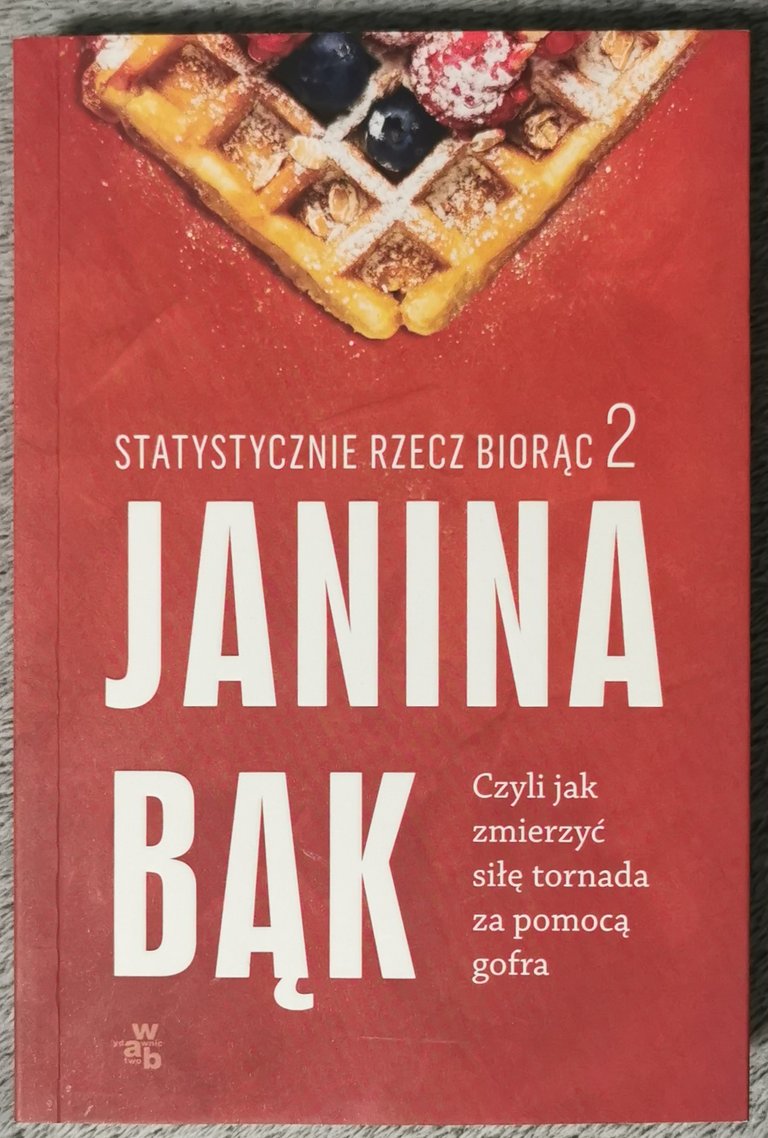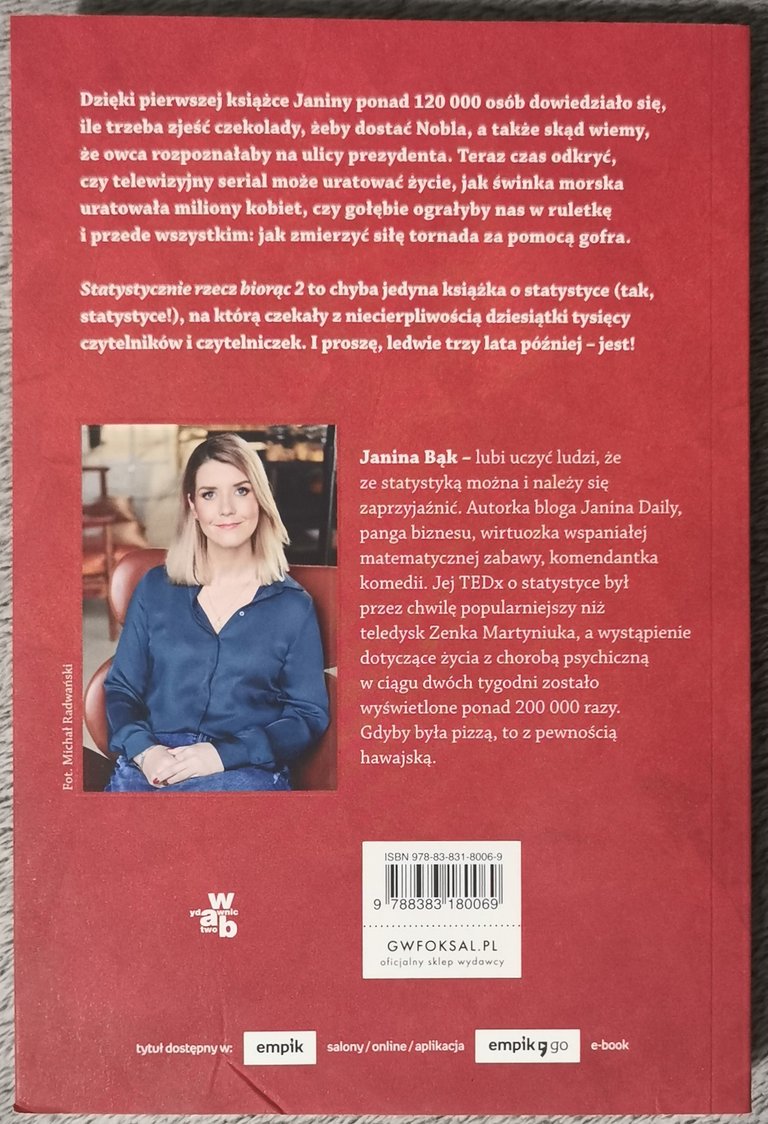[PL/ENG] Czytaj z Marcinem 12/52/2023 - "Statystycznie rzecz biorąc 2: czyli jak zmierzyć siłę tornada za pomocą gofra?", Janina Bąk
(Edited)

| O książkowej działalności Janiny Bąk pisałem już jakiś czas temu. Dziś pora na kontynuację tamtego odcinka, jako że przyszła pora na wrażenia z lektury drugiego tomu „Statystycznie rzecz biorąc”. Ponownie dostajemy intrygujący i zachęcający do zakupu podtytuł – jak zmierzyć siłę tornada za pomocą gofra? | Some time ago I wrote about Janina Bąk's book activities.Today it is time for a continuation of that episode, as it is time for my impressions of reading the second volume of "Statistically Speaking". Once again we are presented with an intriguing and encouraging subtitle - how do you measure the strength of a tornado with a waffle? |
|---|---|
| Tutaj drobne wtrącenie: książkę zakupiłem w czasie targów książki w Warszawie i rzeczywiście – były tam również gofry, którymi można było się poczęstować i zregenerować po dłuuugim staniu w równie dłuuugiej kolejce po autograf autorki i wspólne zdjęcie z kapibarą. | Here is a small interjection: I bought the book at the Warsaw Book Fair, and indeed - there were waffles there too, which I was able to indulge in and recover from the long queue for the author's autograph and photo with her and capybara. |


| Co bardzo doceniam zarówno jako pomysł na promocję, jak też i z punktu widzenia wygłodniałego czytelnika ;) | Which I appreciate both as a promotional idea and from the point of view of a hungry reader ;) |
| Co do samej treści – autorka ponownie przedstawia złożone zagadnienia w sposób możliwie prosty, a do tego maksymalnie pluszowy, tak, by nawet złowrogie pojęcia takie, jak logarytmy, triskaidekafobia czy voodoo nie wywoływały u czytelnika paniki i potrzeby natychmiastowej ucieczki. Pomaga w tym charakterystyczny styl pisania oraz niecodzienne poczucie humoru, które podczas lektury zdołało mnie uśmiechnąć, i to nie raz – a to naprawdę niełatwe. | As for the content itself, the author once again presents complex issues in the simplest and most plushy way possible, so that even dark concepts such as logarithms, triskaidekaphobia or voodoo do not cause the reader to panic and run away. This is aided by a distinctive writing style and an unusual sense of humour that made me smile more than once while reading - and that's not easy to do. |
| Dowiemy się więc, między innymi, co wspólnego mają ze sobą dzieci tzw. cywilizacji zachodniej z amazońskim plemieniem Mundurucu, czy można przechytrzyć prawdopodobieństwo w totolotku (podpowiedź – raczej Was nie stać), o Waffle House Index i jego roli w szacowaniu skutków klęsk żywiołowych (jak sam tytuł wspomina) i o tym, dlaczego w wielu wielokulturowych krajach idąc do lekarza wciąż lepiej jest być białym, niż kolorowym (i bynajmniej nie do końca chodzi o jawny i świadomy rasizm). | Among other things, the book tells us what the children of so-called Western civilisation have in common with the Mundurucu tribe in the Amazon, whether it's possible to beat the odds in a giant lottery (hint: you probably can't afford it), the Waffle House Index and its role in estimating the impact of natural disasters (as the title suggests), and why in many multicultural countries it's still better to be white than coloured when going to the doctor (and it's not all about overt and conscious racism). |
| A z takich bardziej istotnych na co dzień rzeczy – o związkach przyczynowo-skutkowych i sposobach na ich wykrycie, o właściwej metodologii badań statystycznych oraz badań klinicznych w medycynie, o samospełniających się przepowiedniach, o tym, ile osób może być zamieszanych w spisek, jeśli tenże ma się utrzymać przez jakikolwiek sensowny czas, i – co może najwyraźniejsze w życiu codziennym – o całej statystyce wyborczej: o różnego rodzaju sondażach, próbach badawczych i dlaczego właściwie Trump wygrał, choć sondaże mówiły zupełnie co innego. | And the more everyday stuff - about cause-and-effect relationships and how to detect them, about the proper methodology of statistical research and clinical trials in medicine, about self-fulfilling prophecies, about how many people at most can be involved in a conspiracy if that conspiracy is to persist for any meaningful length of time, and - perhaps what is most visible in everyday life - all the election statistics: all kinds of polls, survey samples, and why Trump actually won even though the polls said otherwise. |
| Będzie też o wykorzystaniu statystyki w badaniach humanistycznych, szczególnie literaturoznawczych – choć ten fragment jest autorstwa Michała Choińskiego. Różnice w stylu widać, co prawda, gołym okiem, bez zaprzęgania do tego statystyki – ale nie zmienia to faktu, że treści są równie ciekawe, co u Janiny. Tu dowiadujemy się, że badania statystyczne, a konkretnie – stylometryczne – pozwalają na zweryfikowanie autora tekstu, ustalenie, czy ktoś czasem w tekście autorskim nie grzebał, a jeśli tak, to kto i na ile. I to wcale nie jest ich ostatnie słowo! | There will also be a piece on the use of statistics in humanities research, particularly literary studies - although this is by Michał Choiński. The differences in style can be seen with the naked eye without the use of statistics - but that doesn't change the fact that the content is just as interesting as Janina's. Here we learn that statistical research, or more precisely stylometric research, makes it possible to verify the author of a text, to determine whether someone has sometimes interfered with the author's text, and if so, who it was and to what extent. And this is by no means the last word! |
| Podsumowując – jeśli czytałeś pierwszą książkę i spodobała Ci się, przeczytaj także drugą, a będziesz zadowolony. Jeśli nie czytałeś – nie jest to konieczne, żeby zapoznać się z drugim tomem, są one wystarczająco niezależne od siebie (choć może drugi tom jest odrobinę bardziej zaawansowany). | In summary, if you have read and enjoyed the first book, read the second and you will be satisfied. If you haven't - you don't need that to read the newest volume, they are sufficiently independent of each other (although perhaps the second volume is a bit more advanced). |

| PODSUMOWANIE Rozmiar: przeciętna (319 stron) Szybkość czytania: dość szybko, choć czasem wymaga koncentracji Wciąga: tak Dla kogo: dla wszystkich, każdy może znaleźć tu coś dla siebie (nawet jeśli będą to jedynie anegdotki z życia autorki) | SUMMARY Size: average (319 pages) Reading speed: fairly fast, but requires concentration at times Engaging: yes For whom: for everyone, there is something here for everyone (even if it is just anecdotes from the author's life). |
| Zalety: ważne treści przedstawione w ciekawy i przystępny sposób; język i styl, dzięki którym unika się znużenia poważnymi tematami | Pros: important content presented in an interesting and accessible way; language and style that avoids the tedium of serious topics |
| Wady: musiałbym się ich doszukiwać na siłę: może tylko to, że pierwsza część była – o włos – przyjemniejsza w odbiorze? A może to tylko złudzenie wynikające z różnicy czasowej między czytaniami i już pewnego oswojenia z językiem autorki? | Cons: I would have to look hard to find them: maybe just that the first part was - by a hair - more pleasant to read? Or is it just an illusion due to the time difference between the readings and a certain familiarity with the author's language? |
| Ocena końcowa – 9/10 | Final rating - 9/10 |
0
0
0.000
1 comments
0
0
0.000
Reply